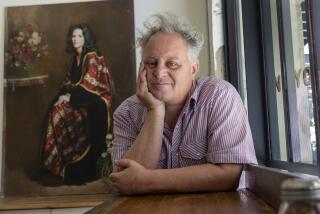Experts Question Purported Gauguin
- Share via
CAIRO — In the 1920s a young, wealthy Egyptian and his French fiancee bought a painting in Paris. It showed a topless Polynesian woman preening on a tropical beach, and it bore the signature of Paul Gauguin.
Today it hangs in Cairo. The woman’s pointed breasts, the pink of the beach, and a sea painted in blues and yellows catch the eye of thousands of visitors to the Mr. and Mrs. Mahmoud Khalil Museum.
There is a problem, however. Some experts consider it a fake.
“It is a typical fraud that pulls together elements found in various well-known paintings of Gauguin. I think none of the Gauguin specialists regard it as genuine,” says Genevieve Lacambre, a conservator at the Musee d’Orsay in Paris.
But a former director of the Khalil museum, Ahmed Sami, disagrees. He says the brush strokes are Gauguin’s and the signature is too natural to be forged. And Khalil--once president of the Egyptian Senate--bought paintings only from reputable dealers, Sami adds.
Sami also has scientific evidence--lab tests on a swatch of canvas that strongly suggest the painting is the work of the French master. If he is right, recent sales indicate that the picture could be worth $1 million to $5 million.
Khalil and his wife left the painting to the Egyptian state with the rest of their remarkable collection. The museum named for them holds two indisputable Gauguins, six Renoirs, six Pissarros, five Monets, an Ingres, a Toulouse-Lautrec and a Van Gogh.
The disputed painting, 24 by 18 inches, is called “Dominique Scene” after the Pacific island better known as Hiva Oa, where Gauguin died in 1903.
The very name adds to the confusion. Gauguin moved from Tahiti to Dominique, about 950 miles northeast, only in 1901. The painting is dated 1894. Could it have been incorrectly named after Gauguin’s death? Gauguin often painted a title on his canvases; there is none on this one.
Lacambre knows the work well because she helped choose the paintings borrowed from the Khalil collection for a 1994 Paris exhibition, “Forgotten Works of Cairo.”
She says the topless woman is painted in a “totally vulgar” style that is not Gauguin’s; that the back of the canvas bears no mark of a dealer; and that the painting is not found in any book of Gauguin’s complete works. “It is authenticated by nothing,” Lacambre says.
The painting strongly resembles Gauguin’s “Day of the God,” which also is dated 1894 and hangs in Chicago’s Art Institute. The topless woman, the landscape and other features are strikingly similar.
For Lacambre, these are the marks of a clever forger. But Sami believes that Gauguin painted both works and, as was his custom, duplicated certain elements.
Sami sent two swatches of unpainted canvas to laboratories in Egypt and Germany for testing. One sample came from the side of the frame of the disputed painting, the other from one of the museum’s authenticated Gauguins.
The tests found the two swatches came from the same roll of canvas--supporting the theory that Gauguin painted both works.
Sami stumbled on another piece of evidence while paging through a 1930 book on Gauguin by the French critic Arsene Alexandre. He came across a print of “Dominique Scene.” He rushed into the gallery to compare the print to the actual painting. They matched in every detail.
Lacambre says Alexandre “could have been mistaken.”
As for Sami’s lab tests, she has no answer. Asked how a fake and a genuine Gauguin could have come from the same roll of canvas, she says: “I cannot tell you.”
On the other hand, Sami, now the museum’s supervisor of cultural activities, has no documentation for the work. The gallery has no record of how Khalil came by the painting. Not even Alexandre mentions it in the text of his book.
Lacambre wrote Egypt’s Ministry of Culture that it was “deplorable” to hang the painting as a Gauguin, arguing that it should be labeled “in the style of Gauguin.”
That advice was rejected, but the painting was hung on the gallery’s ground floor, which is reserved for lesser works.
Sami is fighting to have the painting moved upstairs so it can be seen among the Renoirs, Monets and Pissarros.
More to Read
Sign up for Essential California
The most important California stories and recommendations in your inbox every morning.
You may occasionally receive promotional content from the Los Angeles Times.










